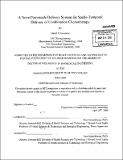| dc.contributor.advisor | Ram Sasisekharan. | en_US |
| dc.contributor.author | Eavarone, David A. (David Alan) | en_US |
| dc.contributor.other | Harvard University--MIT Division of Health Sciences and Technology. | en_US |
| dc.date.accessioned | 2010-09-03T18:34:23Z | |
| dc.date.available | 2010-09-03T18:34:23Z | |
| dc.date.copyright | 2009 | en_US |
| dc.date.issued | 2009 | en_US |
| dc.identifier.uri | http://hdl.handle.net/1721.1/58393 | |
| dc.description | Thesis (Ph. D. in Biomedical Engineering)--Harvard-MIT Division of Health Sciences and Technology, 2009. | en_US |
| dc.description | Cataloged from PDF version of thesis. | en_US |
| dc.description | Includes bibliographical references. | en_US |
| dc.description.abstract | In the continuing search for effective treatments for cancer, the emerging model is the combination of traditional chemotherapy with anti-angiogenesis agents that inhibit blood vessel growth. However, the implementation of this strategy has faced two major obstacles. First, the long-term shutdown of tumor blood vessels by the anti-angiogenesis agent can prevent the tumor from receiving a therapeutic concentration of the chemotherapy agent. Second, inhibiting blood supply drives the formation of intra-tumoral hypoxia, or a lack of oxygen, which has been correlated with increased tumor invasiveness and resistance to chemotherapy. In this thesis we report the disease-driven engineering of a drug delivery system, a 'nanocell', which overcomes these barriers unique to solid tumors. The nanocell comprises a nuclear nanoparticle encapsulated within a lipid membrane and is preferentially taken up by the tumor. The nanocell delivers a temporal release of two drugs within the tumor core: the outer lipid envelope first releases an anti-angiogenesis agent, causing a vascular shutdown; the inner nanoparticle, which is trapped inside the tumor, then releases a chemotherapy agent. This focal release within the tumor targets cells most at risk for hypoxia and results in improved therapeutic index with reduced toxicity. The technology can be extended to additional agents, so as to target multiple signaling pathways or distinct tumor compartments, enabling the model of an 'integrative' approach in cancer therapy. | en_US |
| dc.description.abstract | (cont.) In the second part of the thesis we report new tools for the optimization of nanocell formulations. We present a new, three-dimensional, voxel-based computational model for Monte Carlo simulations of nanoparticle delivery systems that enables direct investigation of the entire vehicle during particle degradation and drug release. Use of this model in combination with emerging mechanistic understandings of nanoparticle drug release will facilitate optimization of nanocell combination therapy release profiles. We additionally report the generation and characterization of a set of carbohydrate-based chemotherapeutic agents that have the potential for use in nanocells as reduced toxicity alternatives to traditional chemotherapy agents. | en_US |
| dc.description.statementofresponsibility | by David A. Eavarone. | en_US |
| dc.format.extent | 121 p. | en_US |
| dc.language.iso | eng | en_US |
| dc.publisher | Massachusetts Institute of Technology | en_US |
| dc.rights | M.I.T. theses are protected by
copyright. They may be viewed from this source for any purpose, but
reproduction or distribution in any format is prohibited without written
permission. See provided URL for inquiries about permission. | en_US |
| dc.rights.uri | http://dspace.mit.edu/handle/1721.1/7582 | en_US |
| dc.subject | Harvard University--MIT Division of Health Sciences and Technology. | en_US |
| dc.title | A novel nanoscale delivery system for spatio-temporal delivery of combination chemotherapy | en_US |
| dc.type | Thesis | en_US |
| dc.description.degree | Ph.D.in Biomedical Engineering | en_US |
| dc.contributor.department | Harvard University--MIT Division of Health Sciences and Technology | |
| dc.identifier.oclc | 650349524 | en_US |
